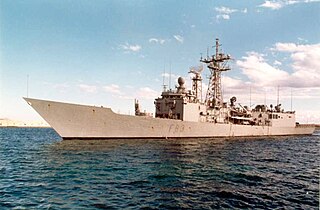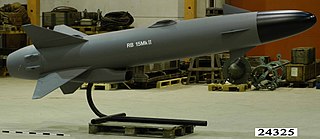
The German Navy is the navy of Germany and part of the unified Bundeswehr, the German Armed Forces. The German Navy was originally known as the Bundesmarine from 1956 to 1995, when Deutsche Marine became the official name with respect to the 1990 incorporation of the East German Volksmarine. It is deeply integrated into the NATO alliance. Its primary mission is protection of Germany's territorial waters and maritime infrastructure as well as sea lines of communication. Apart from this, the German Navy participates in peacekeeping operations, and renders humanitarian assistance and disaster relief. It also participates in anti-piracy operations.

A corvette is a small warship. It is traditionally the smallest class of vessel considered to be a proper warship. The warship class above the corvette is that of the frigate, while the class below was historically that of the sloop-of-war.

The MEKO family of warships was developed by the German company Blohm+Voss. MEKO is a registered trademark. The portmanteau stands for "Mehrzweck-Kombination". It is a concept in modern naval shipbuilding based on modularity of armament, electronics and other equipment, aiming at ease of maintenance and cost reduction.

Santa María (F81) is the lead ship of six Spanish-built Santa Maria-class frigates of the Spanish Navy, based on the American Oliver Hazard Perry class design. The vessel was constructed in 1982 and was launched on 11 November 1984. Santa María was commissioned on 12 October 1986. The frigate has served in NATO maritime operations.

Numancia (F83) is the third of the six Spanish-built Santa Maria-class frigates of the Spanish Navy, based on the American Oliver Hazard Perry class design. The frigate was constructed in Spain by Bazan and was laid down on 8 January 1986, launched on 29 January 1987 and entered service with the Spanish Navy on 17 November 1989. Based at Rota, Numancia has been deployed to the Indian Ocean fighting piracy in Somalia as part of Operation Atalanta and to the Mediterranean Sea intercepting illegal trafficking of migrants as part of Operation Sophia.

Victoria (F82) is the second of the six Spanish-built Santa Maria-class frigates of the Spanish Navy, based on the American Oliver Hazard Perry class design. Constructed in 1983, the vessel was launched on 23 July 1986 and commissioned on 11 November 1987. The frigate has been assigned to Operation Atalanta, fighting piracy of the Somalian coast.

The K130 Braunschweig class is Germany's newest class of ocean-going corvettes. Five ships have replaced the Gepard-class fast attack craft of the German Navy.

The RBS 15 is a long-range fire-and-forget surface-to-surface and air-to-surface anti-ship missile. The later version Mk. IV has the ability to attack land targets as well. The missile was developed by the Swedish company Saab Bofors Dynamics.

The F125 Baden-Württemberg-class frigates are a series of frigates of the German Navy, which were designed and constructed by ARGE F125, a joint-venture of Thyssen-Krupp and Lürssen. The Baden-Württemberg class is the heaviest displacement of any class of frigates worldwide. They have replaced the Bremen class. They are primarily designed for low and medium intensity maritime stabilization operations, where they are supposed to provide sea-to-land tactical fire support, asymmetric threat control at sea and support of special forces.

Operation Atalanta, formally European Union Naval ForceSomalia, is an ongoing counter-piracy military operation at sea off the Horn of Africa and in the Western Indian Ocean, that is the first naval operation conducted by the European Union (EU), in support of United Nations resolutions 1814, 1816, 1838, and 1846 adopted in 2008 by the United Nations Security Council. Since 29 March 2019, the operational headquarters is located at Naval Station Rota in Spain, having moved from London as a result of the British withdrawal from the EU.

Braunschweig(F260) is the lead ship of the Braunschweig-class corvette of the German Navy.

Magdeburg(F261) is the second ship of the Braunschweig-class corvette of the German Navy.

Oldenburg(F263) is the fourth ship of the Braunschweig-class corvette of the German Navy.

Ludwigshafen am Rhein(F264) is the fifth ship of the Braunschweig-class corvette of the German Navy.

Köln(F265) is the sixth ship of the Braunschweig-class corvette of the German Navy.

Emden(F266) is the seventh ship of the Braunschweig-class corvette of the German Navy.

Karlsruhe(F267) is the eighth ship of the Braunschweig-class corvette of the German Navy.

Lübeck(F269) is the tenth ship of the Braunschweig-class corvette of the German Navy.

Augsburg is the ninth ship of the Braunschweig-class corvettes of the German Navy.

















